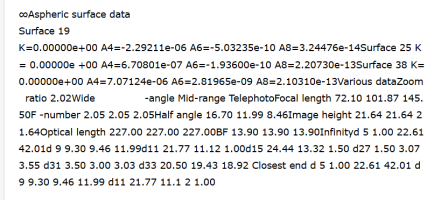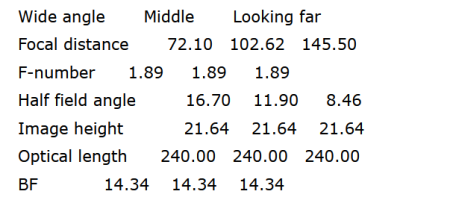You are using an out of date browser. It may not display this or other websites correctly.
You should upgrade or use an alternative browser.
You should upgrade or use an alternative browser.
Patent Application: The Zoom You’ve Dreamt About: 70-150mm F2.0
- Thread starter Richard CR
- Start date
I\'m only posting a comment because the website won\'t let me view the other pages in the thread unless I get there this way. Something to look into, CR team and Craig.
Upvote
0
I'll have what she's havingCanon please, make an ultra-sharp 24-70 f/2 just for me...
(Maximum weight 1 kg.).
Upvote
0
Another site is reporting a variation they describe as a 70-150 f/1.8. The exact specs look like 72-146 @ f/1.89.
Thanks!
I swore I saw that when i first looked at the patent app, and even told Craig there was a 70-150mm F1.8 then when i was writing it up, the machine translate buried that one.
this is what it looks like - most of the times I catch these.

Upvote
0
I just looked through the patent. The f1.8 is numerical example 6 (of 8).Thanks!
I swore I saw that when i first looked at the patent app, and even told Craig there was a 70-150mm F1.8 then when i was writing it up, the machine translate buried that one.
this is what it looks like - most of the times I catch these.
View attachment 220792
It took a long while to fully complete the translation on the Japanese Patent Site.
Edit: Add details.

[0092]
[Numerical Example 6]....

Last edited:
Upvote
0
Thanks I had posted it on the articleI just looked through the patent. The f1.8 is numerical example 6 (of 8).
It took a long while to fully complete the translation on the Japanese Patent Site.
Edit: Add details.
View attachment 220793
[0092]
[Numerical Example 6]....
View attachment 220794
Upvote
0
There is no technical reason why this lens would cost more to design and produce than either of Canon's current 70-200mm f2.8 LIS lenses.Don't we wish.I'll jump out on a limb and say $6k. Final answer.
Upvote
0
I suppose it's the quantities involved - smaller production run will require higher price to cover those costs to make a profit. How many would buy it compared with a 70-200/2.8?There is no technical reason why this lens would cost more to design and produce than either of Canon's current 70-200mm f2.8 LIS lenses.
Upvote
0
Wouldn't virtually all elements and the body itself be significantly larger? More time to grind glass (if they still do that)? Serious question. I profess zero knowledge in lens manufacturing. I'm just see 2.8 vs 4.0 lenses and assume the same jump to get to 2.0 from 2.8.There is no technical reason why this lens would cost more to design and produce than either of Canon's current 70-200mm f2.8 LIS lenses.
Upvote
0
Yes, glass is still being ground and polished. This doesn't apply to some pressed glass lenses and, of course, to the acrylic ones.Wouldn't virtually all elements and the body itself be significantly larger? More time to grind glass (if they still do that)? Serious question. I profess zero knowledge in lens manufacturing. I'm just see 2.8 vs 4.0 lenses and assume the same jump to get to 2.0 from 2.8.
Upvote
0
If the lens was 70-200, then yes. But the rumor is 70-150. 200/2.8 = 71.4mm, 150/2 = 75mm, not too different. For an analogy, look at the 24-105/2.8 vs. the 28-70/2 – the former is longer and the other is fatter but they're only 100g different in weight.Wouldn't virtually all elements and the body itself be significantly larger? More time to grind glass (if they still do that)? Serious question. I profess zero knowledge in lens manufacturing. I'm just see 2.8 vs 4.0 lenses and assume the same jump to get to 2.0 from 2.8.
Upvote
0
The RF-S 7.8mm f/4 Dual is only $450.Are there any rumors about when Canon might come out with more affordable lenses?
Upvote
0
@Canon Rumors Guy
another f/2 zoom to “compliment” the RF 28-70mm
https://www.canonrumors.com/is-something-like-the-rf-70-150mm-f-2l-usm-actually-coming/
Complement = to complete
Compliment = to say nice things
another f/2 zoom to “compliment” the RF 28-70mm
https://www.canonrumors.com/is-something-like-the-rf-70-150mm-f-2l-usm-actually-coming/
Complement = to complete
Compliment = to say nice things
Upvote
0
No they wont. The math tells us that the lens will be of similar size and bulk, maybe even slightly smaller than the current 70-200/2.8. it's reasonable to assume that it will be shorter in physical length.Wouldn't virtually all elements and the body itself be significantly larger? More time to grind glass (if they still do that)? Serious question. I profess zero knowledge in lens manufacturing. I'm just see 2.8 vs 4.0 lenses and assume the same jump to get to 2.0 from 2.8.
The aperture value / rating of a lens is a ratio between the diameter of the front element and the focal length of the lens. So fo example a 300mm f2.8 will have a from element diameter of approximatly 100mm. Put the 200mm f2.8 into the same math grinder an your get approximatly 72mm. Put a 140mm f2 into the same equation and we see 70mm. Canon often upsize their front element and then use the pupil size to obtain similar light transmission / simlated aperture values. For instance, there is no aperture related reason why a 28-70mm f2.0 lens needs a 95mm diameter front element. It might be good for other optical reasons, but it's not related to the lens' aperture value.
If you look back at the original EF 80-200mm f2.8 (aka the magic Drain Pipe), you will see that it's front element is only 72mm and yet it is a 200mm f2.8 optic.
Last edited:
Upvote
0
True. But it's f/2. It was just a guess based on nothing. It wasn't serious.There is no technical reason why this lens would cost more to design and produce than either of Canon's current 70-200mm f2.8 LIS lenses.
Upvote
0
I think start with Gym first...Hmmm... an RF 28-70mm f/2L and RF 70-150mm f/2L combo. I just don't know.
Upvote
0
Not quite. The f/number (‘aperture value’) is the ratio between the focal length and the diameter of the entrance pupil (the optical representation of the physical iris diaphragm).The aperture value / rating of a lens is a ratio between the diameter of the front element and the focal length of the lens. …
Upvote
0
Ahh, ok...has canon ever relased their diaphragm size data on their lens specs?Not quite. The f/number (‘aperture value’) is the ratio between the focal length and the diameter of the entrance pupil (the optical representation of the physical iris diaphragm).
Upvote
0
Similar threads
- Replies
- 42
- Views
- 2K
- Replies
- 1
- Views
- 241
- Replies
- 2
- Views
- 291
